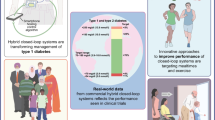Conclusion
In normal animals and human beings the intake of food is precisely regulated to the level of energy expenditure, thus keeping body stores constant. The mechanisms by which this regulation is accomplished include oropharyngeal, gastrointestinal, blood chemical, tissue metabolic, and other factors. The ultimate integration of the information received from these various sites is accomplished by the central nervous system. Although many parts of the central nervous system participate, several areas in the hypothalamus have been identified which exert profound inhibitory or facilitatory influences on feeding reflexes.
The nature of the defect or defects in regulation which lead to obesity in human subjects is unknown.
Similar content being viewed by others
References
Anderson, B., andLarsson, S. Water and food intake and the inhibitory effect of amphetamine on drinking and eating before and after “prefrontal lobotomy” in dogs.Acta physiol. scandinav. 38:29, 1956.
Brobeck, J. R. Neural regulation of food intake.Ann. New York Acad. Sc. 63:44, 1955.
Brobeck, J. R. Neural basis of hunger, appetite, and satiety.Gastroenterology 32:169, 1957.
Grossman, M. I. Integration of current views on the regulation of hunger and appetite.Ann. New York Acad. Sc. 63:76, 1955.
Grossman, M. I. Nutrition and nutritional diseases.Ann. Rev. Med. 8:177, 1957.
Janowitz, H. D., andHollander, F. The time factor in the adjustment of food intake to varied caloric requirement in the dog: A study of the precision of appetite regulation.Ann. New York Acad. Sc. 63:56, 1955.
Mayer, J. Regulation of energy intake and the body weight: The glucostatic theory and the lipostatic hypothesis.Ann. New York Acad. Sc. 63:15, 1955.
Mayer, J. The physiological basis of obesity and leanness.Nutrition Abstr. & Rev. 25:597, 871, 1955.
Mellinkoff, S. M.,et al. Relationship between serum amino acid concentration and fluctuations in appetite.J. Appl. Physiol. 8:535, 1956.
Miller, N. E. Experiments on motivation.Science 126:1271, 1957.
Schulman, J. L.,et al. Effect of glucagon on food intake and body weight in man.J. Appl. Physiol. 11:419, 1957.
Stunkard, A. J., Van Itallie, T. B., andReis, B. B. The mechanism of satiety: Effect of glucagon on gastric hunger contractions in man.Proc. Soc. Exper. Biol. & Med. 89:258, 1955.
Author information
Authors and Affiliations
Rights and permissions
About this article
Cite this article
Grossman, M.I. Regulation of food intake. Digest Dis Sci 3, 659–668 (1958). https://doi.org/10.1007/BF02231238
Issue Date:
DOI: https://doi.org/10.1007/BF02231238




